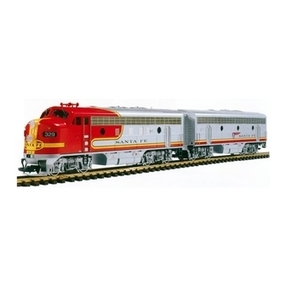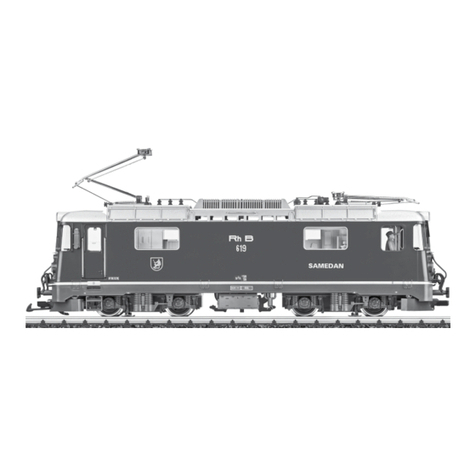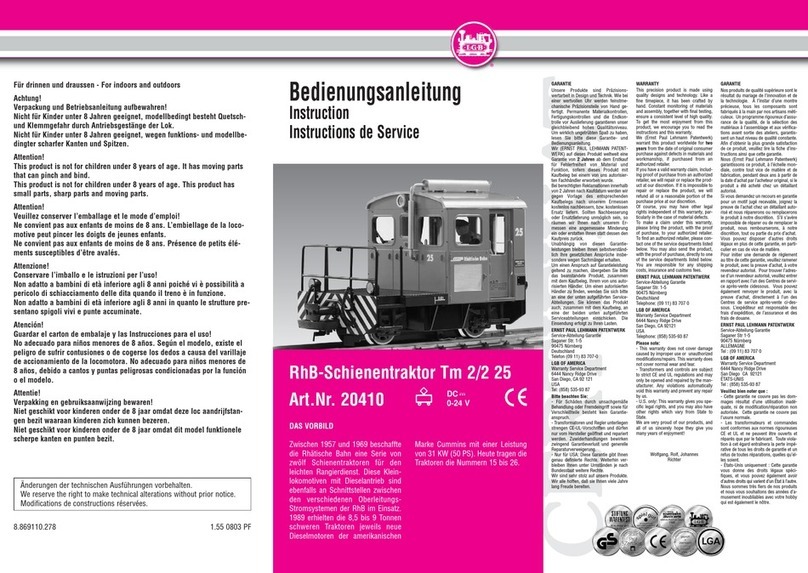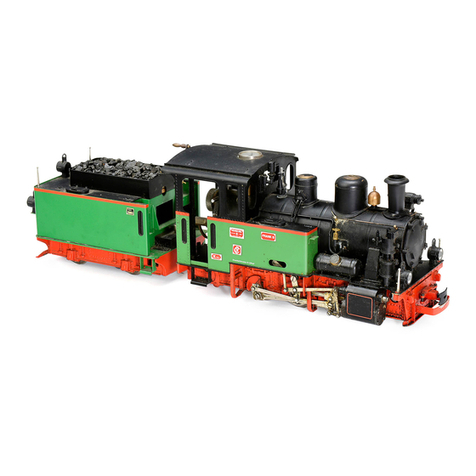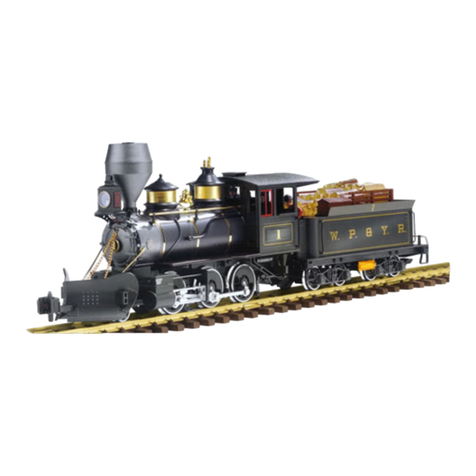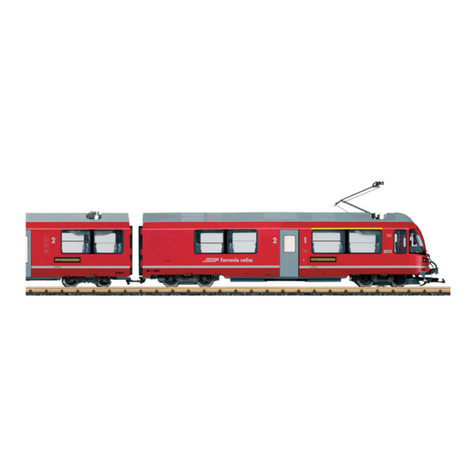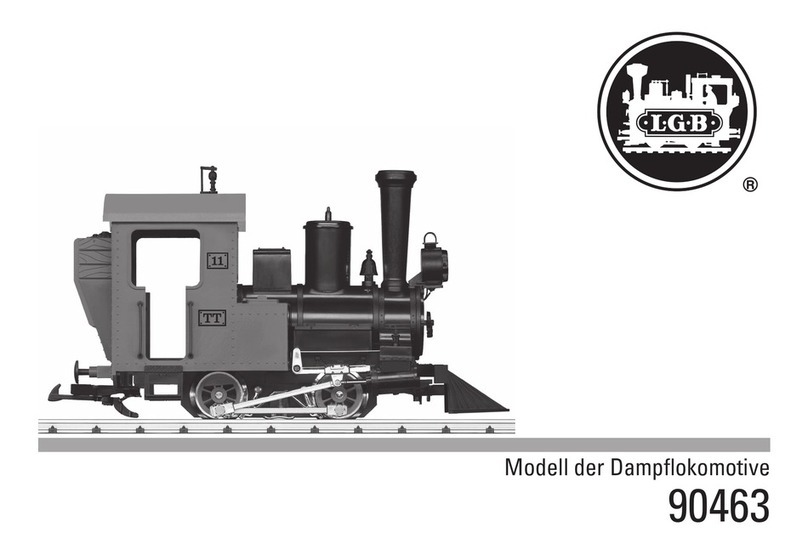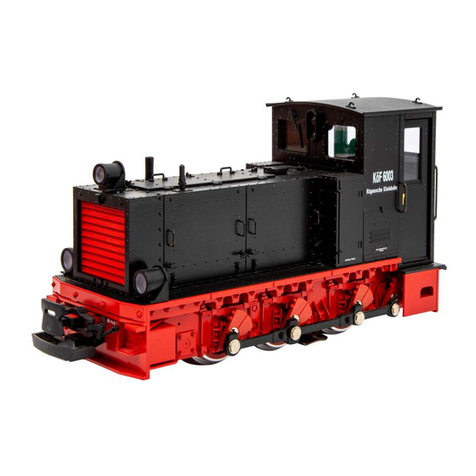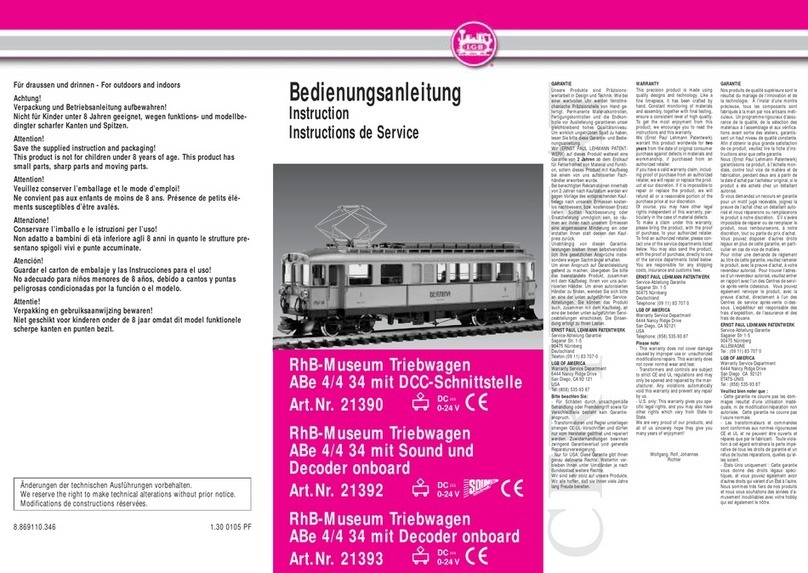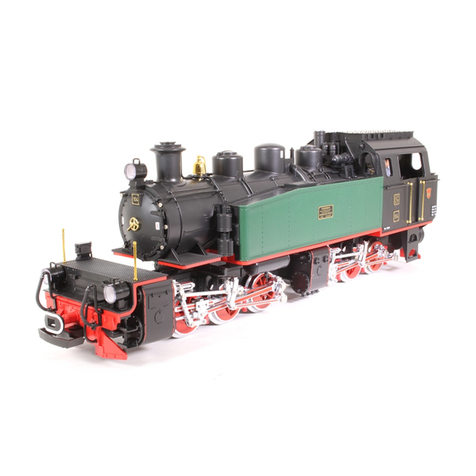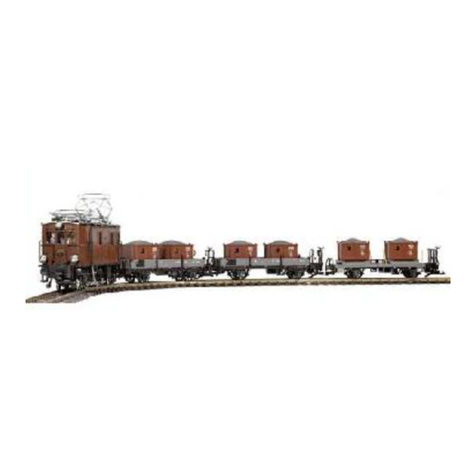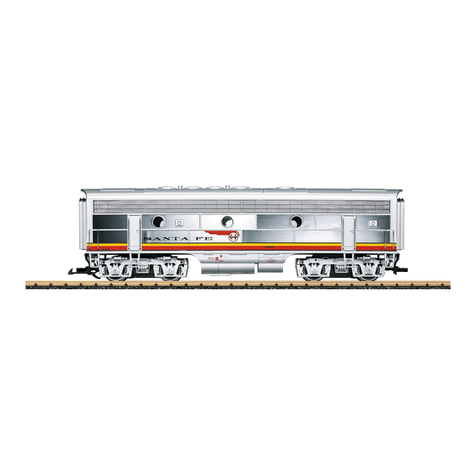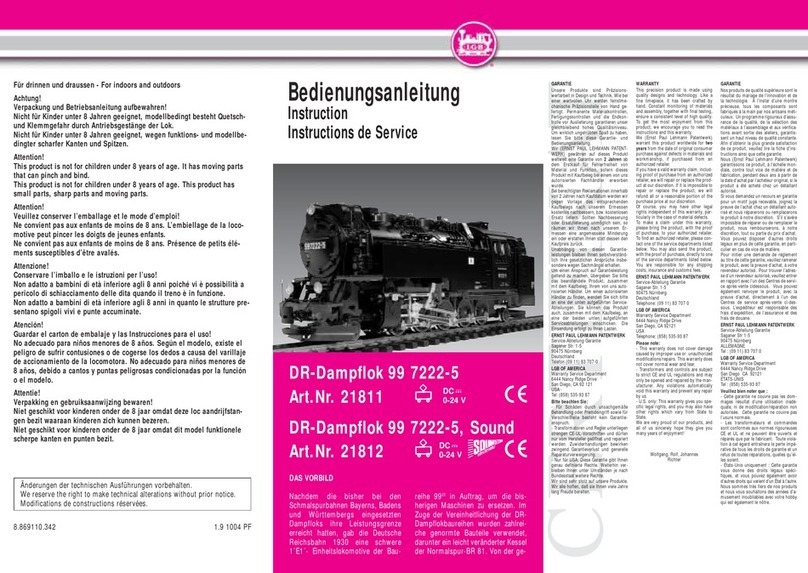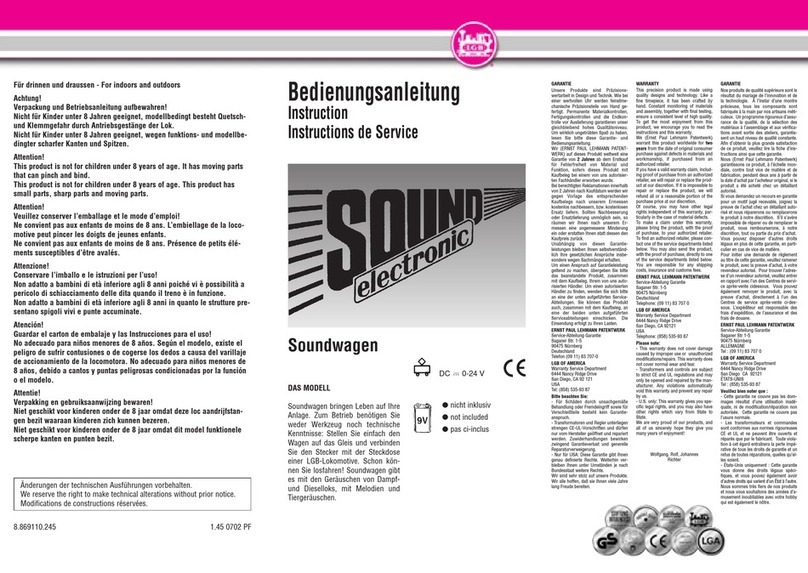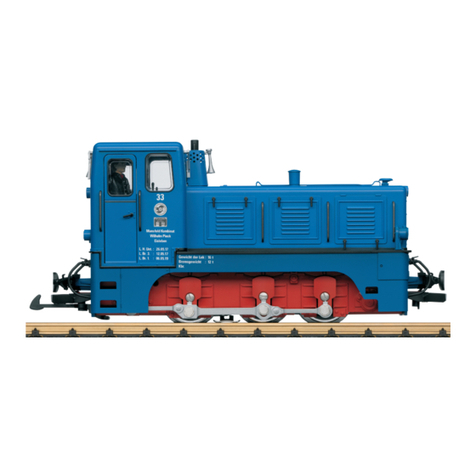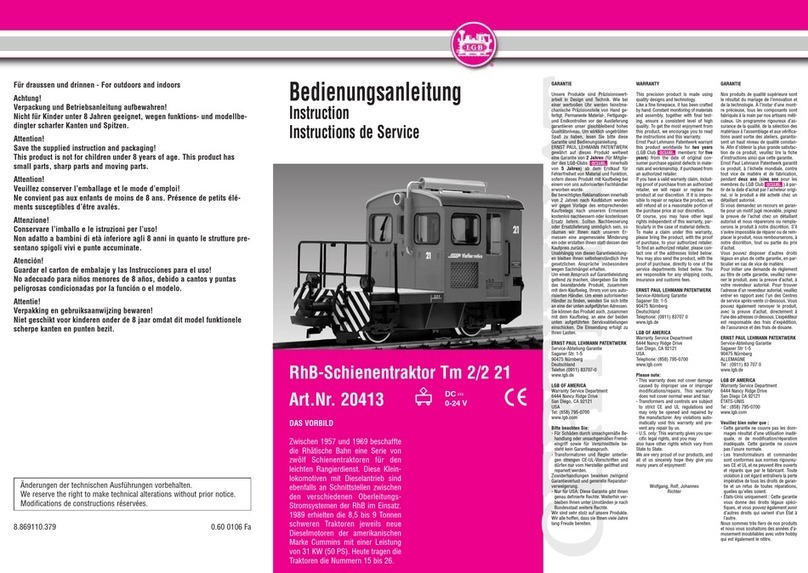4
Sicherheitshinweise
• DasModelldarfnurmiteinemdafürbestimmten
Betriebssystem eingesetzt werden.
• NurSchaltnetzteileundTransformatorenverwenden,
die Ihrer örtlichen Netzspannung entsprechen.
• DasModelldarfnurauseinerLeistungsquelleversorgtwerden.
• BeachtenSieunbedingtdieSicherheitshinweiseinderBedienungsanleitungzu
Ihrem Betriebssystem.
• NichtfürKinderunter15Jahren.
• ACHTUNG!FunktionsbedingtescharfeKantenundSpitzen.
• VerbauteLED`sentsprechenderLaserklasse1nachNormEN60825-1.
•
Dieses Produkt enthält Magnete. Das Verschlucken von mehr als einem Magneten
kann unter Umständen tödlich wirken. Gegebenenfalls ist sofort ein Arzt aufzusuchen.
Wichtige Hinweise
• DieBedienungsanleitungistBestandteildesProduktesundmussdeshalbaufbe-
wahrt sowie bei Weitergabe des Produktes mitgegeben werden.
• GewährleistungundGarantiegemäßderbeiliegendenGarantieurkunde.
• FürReparaturenoderErsatzteilewendenSiesichbitteanIhrenLGB-Fachhändler.
• Entsorgung:www.maerklin.com/en/imprint.html
• AufgrunderbesonderenOberächedesGehäusesundeinigerAnbauteileist
besondereVorsichtimUmgangmitderLokerforderlich.AufdenglänzendenTeilen
könnensichFingerabdrückeabzeichnen.BittebeachtenSie,dasszurReinigung
keineLösungsmittelodergrobeTücherverwendetwerdendürfen.Beschädigte
EinzelteilekönnenüberdenMärklinReparaturservicegetauschtwerden.
Funktionen
• DasModellistfürdenBetriebaufLGB-Zweileiter-Gleichstrom-Systemenmit
herkömmlichenLGB-Gleichstrom-Fahrpultenvorgesehen(DC,0–24V).
• WerkseitigeingebauterMultiprotokoll-Decoder(DC,DCC,mfx).
• ZumEinsatzmitdemLGB-Mehrzugsystem(DCC)istdasModellaufLokadresse03
programmiert.ImBetriebmitmfxwirddieLokautomatischerkannt.
• Mfx-TechnologiefürMobileStation/CentralStation.
NameabWerk:Xrot 9213
• DieFunktionenkönnennurparallelaufgerufenwerden.DieseriealleFunktionsaus-
lösungistnichtmöglich(beachtenSiehierzudieAnleitungzuIhremSteuergerät).
Allgemeiner Hinweis zur Vermeidung elektromagnetischer Störungen:
UmdenbestimmungsgemäßenBetriebzugewährleisten,isteinpermanenter,
einwandfreierRad-Schiene-KontaktderFahrzeugeerforderlich.FührenSiekeine
VeränderungenanstromführendenTeilendurch.
Hinweise
• DasModellmussvordemerstenBetriebgeschmiertwerden
• WenndasModellmitaktivemDampfgeneratorbetriebenwird,sokanninsBeson-
derederdurchdieZylinderausströmendeDampfdieGleisestarkverschmutzen.
• DiesesModellisthinsichtlichderTechnikunderAusführungbesondersaufwän-
dig und hochwertig. Die meisten angesteckten oder verbauten Teile sind aus
Metallgefertigt.SolcheTeilekönnennichtsoeinfachgetauschtwerden,wie
z.B.Kunststoffteile.BittebeachtenSiedaher,dassSiediesesModellbesonders
vorsichtig handhaben sollten.
Betriebsartenschalter
InderSchneeschleuderistein2-stugerBetriebsartenschalter(Bild1).
Pos. 0 Schneeschleuder stromlos abgestellt
Pos. 1 alles an
Rauchgenerator
In der Schneeschleuder ist ein radsynchroner Rauchgenerator eingebaut. Wegen
derhohenLeistungsaufnahmekannerfürdenAnalogbetriebübereinenSchalter
ausgeschaltetwerden(Bild1).
DasRauchöl(Märklin02421)wirdüberdenDampfschlotnachgefüllt(max.10ml
einfüllen).WirddieSchneeschleudermitgefülltemDampfgeneratorgekippt,soläuft
dasDampfölübereinenÜberlaufdurchdieZylinderwiederaus.
Schneeschleuder
Die Drehrichtung des Schleuderrades ist im Digigalbetrieb umschaltbar.
AusSicherheitsgründenistdieDrehkraftamSchleuderradreduziert.DieSchnee-
schleuderistnichtfürdenpraktischenEinsatzimSchneegeeignet.
(DieSchneeschleuderkannnichtzumwirklichenSchneeräumeneingesetztwerden.)
VordemSchleuderradsindlinksundrechtsKlappenangeordnet,diefürdenBetrieb
geöffnetundmitbeiliegendenStangenxiertwerdenkönnen(Bild2&3).
BeachtenSie,dassdieSchneeschleudermitgeöffnetenKlappendasLichtraumprol
aufdemGleisüberschreitet.
Elektronischer Sound
DiePfeifekannauchmitdemLGB-Sound-Schaltmagneten(17050)ausgelöstwerden.
DerSchaltmagnetlässtsichzwischendieSchwellendermeistenLGB-Gleiseklipsen.
PlatzierenSiedenMagnetenmitdemLogoaufderrechtenbzw.linkenSeitedes
Gleises,umdiePfeifekurz/langauszulösen,wenndasModelldieseStelleüber-
quert.






